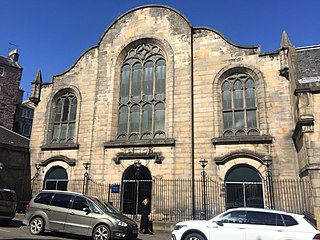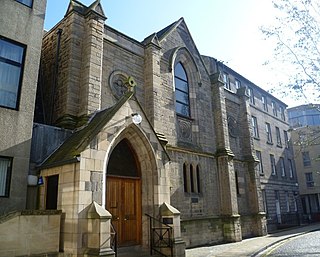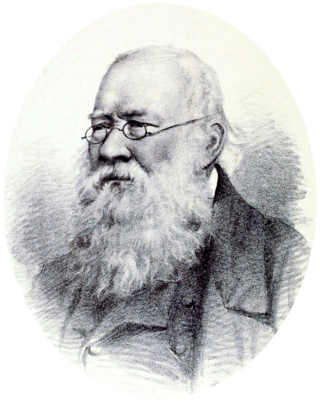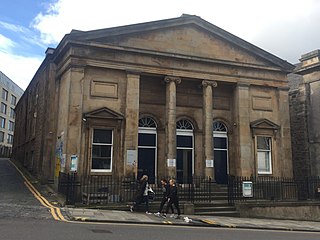

Robert Lee FRSE (1804-1868) was the first Professor of Biblical Criticism at the University of Edinburgh. He was both minister of Old Greyfriars Kirk and a Dean of the Chapel Royal serving Queen Victoria.


Robert Lee FRSE (1804-1868) was the first Professor of Biblical Criticism at the University of Edinburgh. He was both minister of Old Greyfriars Kirk and a Dean of the Chapel Royal serving Queen Victoria.


He was born in Tweedmouth on 21 November 1804, the eldest of three sons to Jane Lambert and George Lee, a boat-builder from a long line of boat-builders on the River Tweed. He was educated at Berwick Grammar School. He was then apprenticed into the family business, working as a boat-builder for six years. However, in 1824, his family seeing his potential, paid for him to study classics at the University of St Andrews in Scotland. He supplemented his income by tutoring the young George Whyte-Melville. [1]
He was licensed by the Presbytery of St Andrews in 1832 and ordained as a minister of the Church of Scotland in 1833, his first charge being Inverbrothock Chapel of Ease, near Arbroath. In 1836 he was translated to Campsie, Stirlingshire. [2]
In 1843 he was chosen to be minister of Old Greyfriars Kirk in Edinburgh, a prestigious charge. Unlike many of his peers, he did not leave the established church in the Disruption of 1843 and remained with the established church. The University of St Andrews awarded him with a doctorate (DD) in 1844. He was appointed a Chaplain in Ordinary to Her Majesty in 1846. [3] In 1847 he became the first Professor of Biblical Criticism at the University of Edinburgh. He lived at 24 George Square in Edinburgh, not far from his church. [4]
In 1853 he was elected a Fellow of the Royal Society of Edinburgh his proposer being John Russell. [2]
From 1857 he began a major reform of the Presbyterian Church Service: he restored the reading of prayers, and introduced the practice of kneeling to pray and standing to sing. Singing in the Protestant Church had long been plain-song. He began the reintroduction of music: adding a harmonium to Greyfriars in 1863 and its first organ in 1865. [5]
He was gravely ill for the last 9 months of his life following a fall from his horse on Princes Street after an evening out with fellow ministers on 22 May 1867, the eve of the General Assembly of the Church of Scotland 1867. In late autumn 1867 he gave up his ministry and went to live with a friend Rev Alfred Edersheim in Torquay in southwestern England, hoping the climate would improve his health. He died there on 14 March 1868. [6]
His body was returned to Edinburgh for burial and he is buried in the south-east section of Grange Cemetery in southern Edinburgh. The pale sandstone monument, bearing his head in high relief, was sculpted by John Hutchison.
His wife was given a civil list pension of £100 per annum. [5]
In June 1836 he married Isabella Carrack Buchanan (d.1889), who was from Campsie parish where he was minister. They had four daughters and one son;
His portrait, by James R. Edgar, is held by the National Gallery of Scotland. [7]
A pair of memorials exist to Lee within Greyfriars Kirk.

William Garden Blaikie FRSE was a Scottish minister, writer, biographer, and temperance reformer.

The Free Church of Scotland is a Scottish denomination which was formed in 1843 by a large withdrawal from the established Church of Scotland in a schism known as the Disruption of 1843. In 1900, the vast majority of the Free Church of Scotland joined with the United Presbyterian Church of Scotland to form the United Free Church of Scotland. In 1904, the House of Lords judged that the constitutional minority that did not enter the 1900 union were entitled to the whole of the church's patrimony ; the residual Free Church of Scotland acquiesced in the division of those assets, between itself and those who had entered the union, by a Royal Commission in 1905. Despite the late founding date, Free Church of Scotland leadership claims an unbroken succession of leaders going back to the Apostles.

William Lindsay Alexander FRSE LLD was a Scottish church leader.

Alexander Henderson was a Scottish theologian, and an important ecclesiastical statesman of his period. He is considered the second founder of the Reformed Church in Scotland. He was one of the most eminent ministers of the Church of Scotland in the most important period of her history, namely, previous to the middle of the seventeenth century.

Greyfriars Kirk is a parish church of the Church of Scotland, located in the Old Town of Edinburgh, Scotland. It is surrounded by Greyfriars Kirkyard.

Reverend Dr John Lee FRSE was a Scottish academic and polymath, and the Principal of the University of Edinburgh from 1840 to 1859. He was Moderator of the General Assembly of the Church of Scotland in 1844.
Gilbert Rule was a nonconformist Church of Scotland minister and the Principal of the University of Edinburgh from 1690 to 1701.

Archibald Hamilton Charteris was a Scottish theologian, a Moderator of the General Assembly of the Church of Scotland, professor of biblical criticism at the University of Edinburgh and a leading voice in Church reforms. He is credited as being the father of the Woman's Guild and founder of "Life and Work" magazine.
Thomas Sydserf(f), or St. Serf, (1581 – 1663) was a Scottish minister of the Church of Scotland who served as Protestant Bishop first of Brechin, then Galloway and finally Orkney.

Trinity College Kirk was a royal collegiate church in Edinburgh, Scotland. The kirk and its adjacent almshouse, Trinity Hospital, were founded in 1460 by Mary of Gueldres in memory of her husband, King James II who had been killed at the siege of Roxburgh Castle that year. Queen Mary was interred in the church, until her coffin was moved to Holyrood Abbey in 1848.

Lady Yester's Kirk was a parish church of the Church of Scotland and one of the burgh churches of Edinburgh. Founded in 1647, it served the south-eastern part of Edinburgh's Old Town until its union with Greyfriars Kirk in 1938.
George Washington Sprott was Scottish minister and liturgical scholar, known as an advocate of reform of the services of the Church of Scotland, and of its reunion with the Free Church of Scotland.

Archibald Campbell Douglas was a Scottish architect based primarily in Glasgow. He designed many churches in Glasgow and Edinburgh, especially those for the Free Church of Scotland.

The King Khalid Building is an event space in the Southside, Edinburgh, Scotland, owned and operated by the Royal College of Surgeons of Edinburgh. The building was constructed Roxburgh Free Church in 1847 and converted to its current use in 1982.
James Sellar (1812–1886) was a Scottish minister who served as Moderator of the General Assembly of the Church of Scotland in 1875.

Patrick Clason was a Scottish minister who served as Moderator of the General Assembly to the Free Church of Scotland in 1848/49.

William Robertson (1805–1882) was a Scottish minister of the Church of Scotland and a primary promoter of the 19th century concept of ragged schools and urban missions. The Robertson Memorial Mission in Edinburgh's Grassmarket is named after him.

St Oran's Church was a Gaelic-speaking congregation of the Church of Scotland in Edinburgh. Originating in the early 18th-century, the congregation continued until 1948, latterly meeting at Broughton Street.